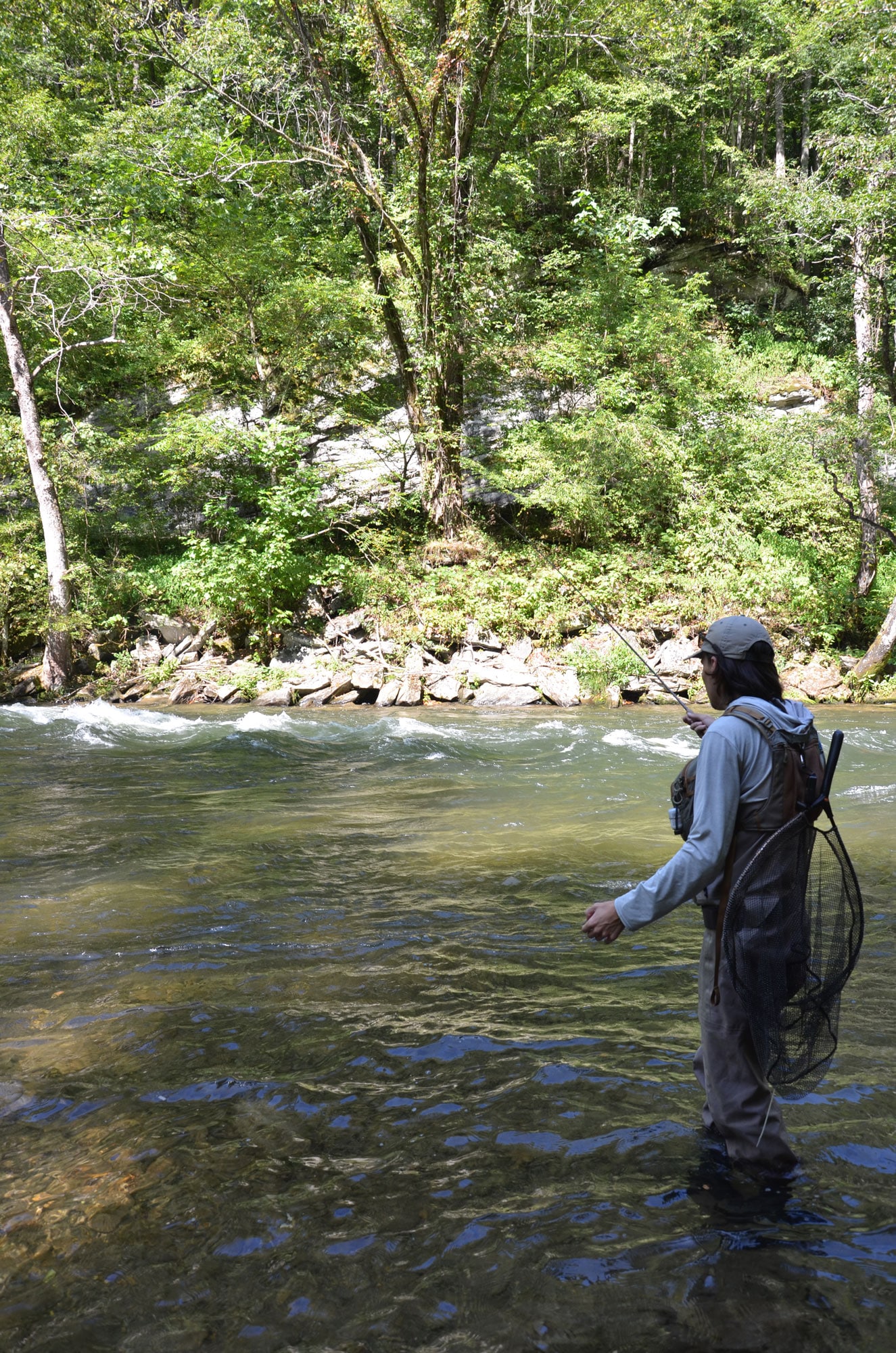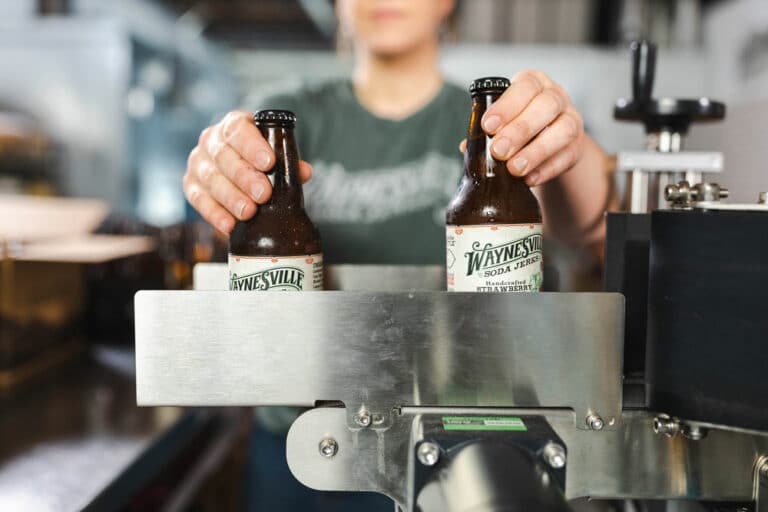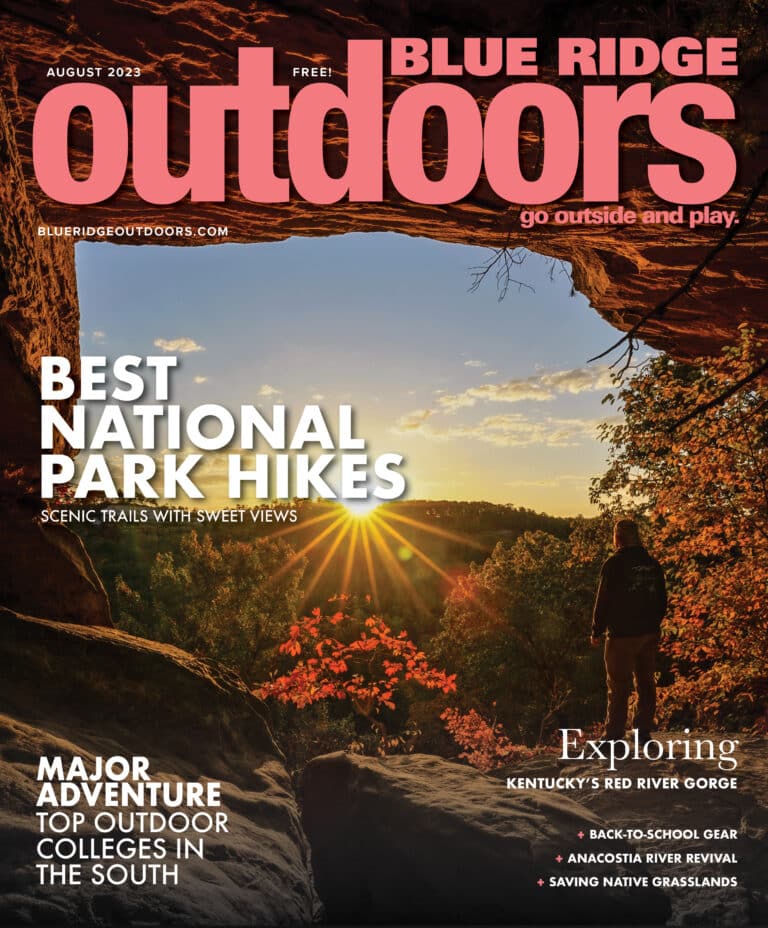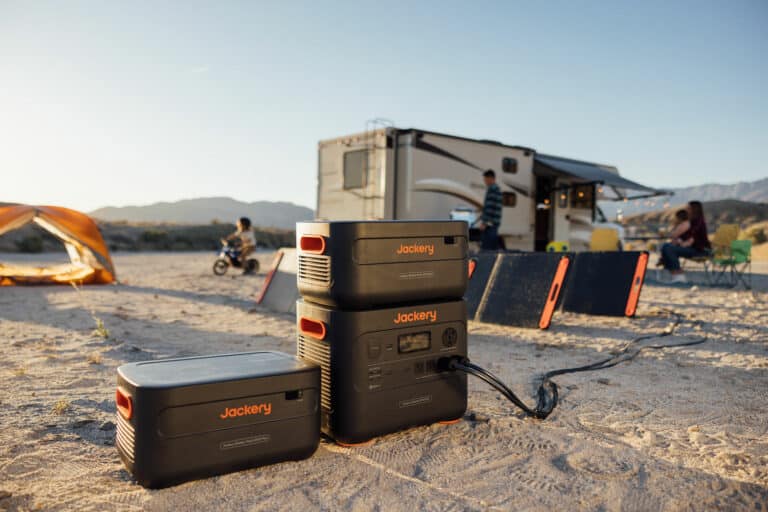With this fly fishing technique you can catch more trout, more efficiently
If you’ve spent much time in fly shops or trout streams over the last decade, you’ve likely heard about Euro nymphing. It’s a style of fly fishing that flat-out catches fish, and its rise in popularity is a testament to its effectiveness.
A Euro nympher is the angler you see standing over a run like a heron, meticulously fishing the water directly in front of him with a long flimsy rod and an extra-long parti-colored leader. Chances are that angler is catching a lot more fish than you are.
You—the traditional fly fisher—might look cool and have a lot of fun with your long casts and tight loops, but you should know there is a more efficient way to take advantage of the following three truths about trout: a vast majority of their feeding is done subsurface, they eat insects drifting naturally with the current, and there are usually a lot more fish down there than you think.
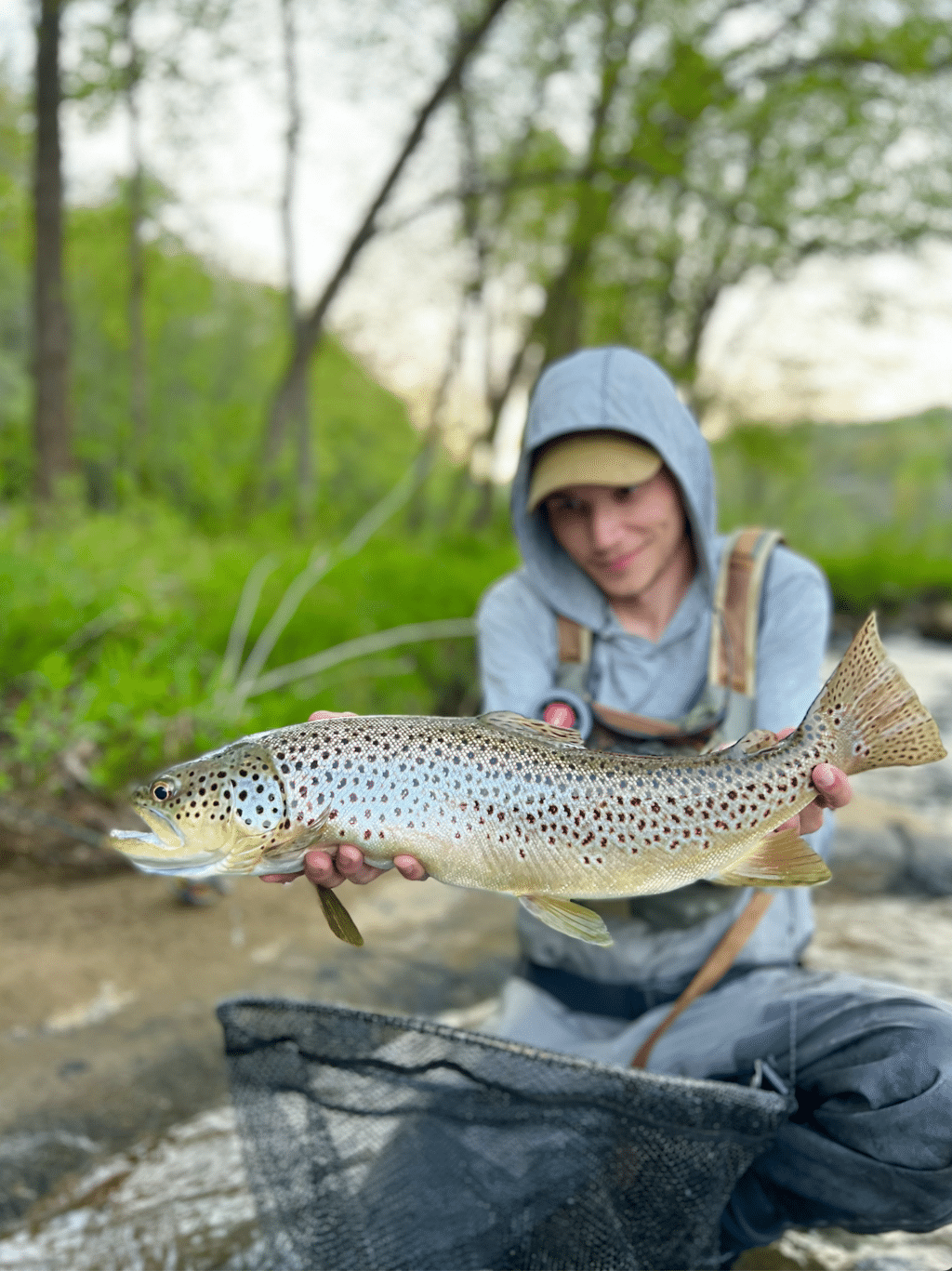
Euro nymphing is a more effective way to catch numbers of fish in most circumstances. If a traditional fly fisher is like an artist with a canvas and brushes, a Euro nympher is a carpenter hanging siding with a nail gun…or an engineer analyzing variables to achieve a specific result. The technique has proven itself over the years by dominating the world of competitive fly fishing, where victories are awarded to anglers who catch the most fish.
As the name implies, Euro nymphing originated in Europe, where fly fishing tournaments are a big deal. The technique’s relatively recent rise in the U.S. can be attributed to American anglers who brought it back from international competition.
Grant Hawse is one of those anglers. He’s a 24-year-old fishing guide from Sylva, N.C., who guides for Fish Tales Outfitters in Franklin. He’s a former member of the U.S. Youth Fly Fishing Team and one of the six anglers who represented the U.S. in the World Youth Fly Fishing Championships in Spain and Slovenia in 2016 and 2017. In Slovenia, Hawse placed in the top 10 worldwide, leading the U.S. team to a strong third-place finish under very tough drought conditions.
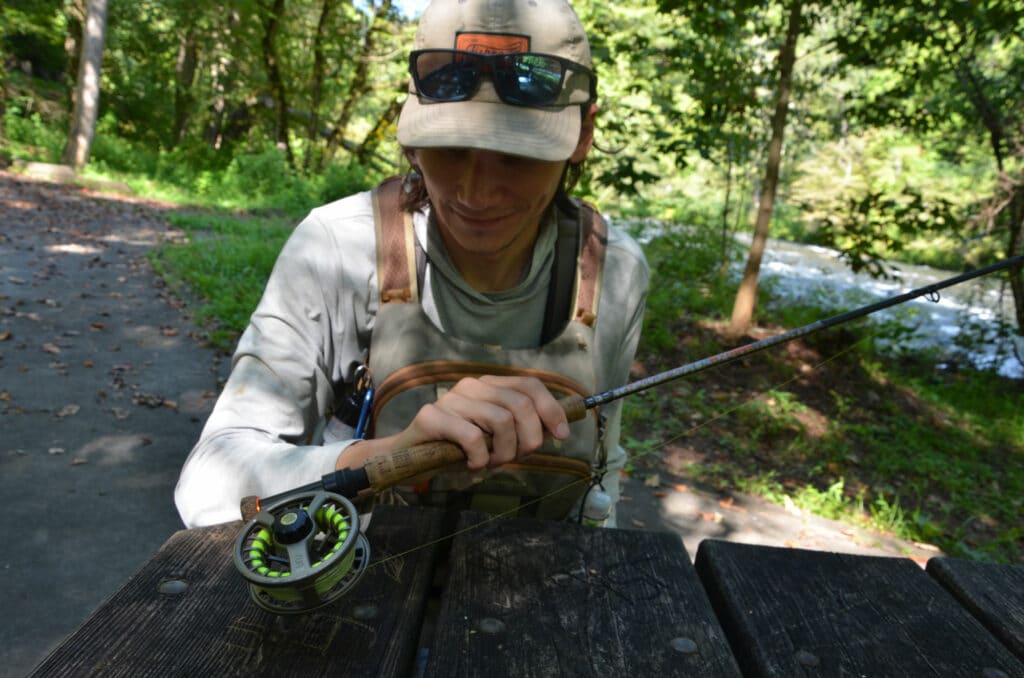
Hawse knows a lot about Euro nymphing and fishing in general. He showed me his gear and rigging and allowed me to pick his brain while we sat at a picnic table on the bank of the Nantahala River. We were both eager to get on the water, and our attention wavered each time a juicy mayfly floated past on the breeze, but he was just as eager to share his theories on fly fishing.
“My time with the U.S. team was awesome. The amount of information we learned and the people we got to fish with was incredible,” Hawse said. “I think that’s why we learned so much so fast… the people we fished with.
“Every country has its own style, and that’s where it all came from,” he continued. “The Czechs, the French, all of them do it differently, and we took some from all their styles. A lot of what I learned is you can always learn from anyone. I even learn things from my clients sometimes.”
Hawse fishes dry flies when fish are actively rising to the surface, but when they aren’t looking up, he uses specialized Euro nymph rods and rigs to fish subsurface. Later, on the water, he showed me just how effective the technique can be.
The Theory
Trout—in most places, in most weather and water conditions—spend most of their time feeding on aquatic insects adrift in the current below the surface. Fish prefer to hover near river bottoms, where current is slowed as it drags across obstacles. They dart up to snatch morsels out of the flow.
With polarized glasses, you can see this behavior as a flash of silver sunlight reflecting off a trout’s side when it turns to grab a bug from the current. In clear water, you might even see fish hanging almost motionless over the streambed. If you see one fish, there are likely others, sometimes many others, right there in the same area.
“You want to grid the river out and fish from the bottom of a run to the top and from the top of the water column to the bottom,” Hawse said. “Sometimes the biggest fish sit in the tail outs. You know it when you step into it and spook them.”
By gridding the river out, Hawse meant actually visualizing a three-dimensional grid and using numerous casts to systematically drift a nymph rig through each part of it. Traditional anglers can sort of achieve this by fishing nymphs under an indicator and laboriously adjusting depth or even swinging their rod tip with the current to drift heavy nymphs on a tight line. A Euro rig is more efficient. An angler proficient with the technique can fish every inch of water within reach with precision, absolute depth control, and limited drag. That equates to a more natural-looking drift of the nymph in every part of a run at every depth in the water column. This is why Euro nymphing consistently produces more fish. By fishing meticulously, an angler can put the fly on the nose of every fish in a run, whether fish are visible or not.
This presentation requires some specialized gear and techniques. It involves making short, repetitive casts with a super-long leader, and the fly line never leaves the reel in most situations.
“Some people hate Euro nymphing because they think it’s not fly fishing,” Hawse said. “But it’s just another tool you can use to catch fish, and that’s the point, right?”
Euro Nymphing Gear
At the core of fly fishing is the concept that the angler is casting the fly line, rather than the weight of a lure. The momentum of the line pulls the fly to the target. In Euro nymphing, fly line is not a primary consideration. With a leader that is 30 feet or longer, the main fly line usually doesn’t even leave the reel.
The angler uses a long rod and the weight of a heavy nymph on light line to simply flick out short casts. Then the rod is used to lead the drift and control the depth of the fly. On the drift, the technique is akin to walking a good dog that doesn’t pull at the leash. The angler is always in loose contact with the fly, which allows for depth control, sensitive bite detection, and hook sets that should be as quick as a snake bite.
Hawse said anglers develop their own personal preferences for rods, reels, lines, and leaders, and his competition rig strays from the norm. He uses a 10-foot, 2-weight Reddington Strike Euro Nymph rod, and said the reel doesn’t matter, as long as its weight balances out the setup. A 3- or-4-weight rod is a more typical choice for Euro nymphing, but Hawse feels the flexible 2-weight rod protects his light tippet when battling large fish. Believe it or not, he’s brought 30-inch fish to net with this setup.
His main line is specialized to Euro nymphing. It is very thin coated braid, similar to fly line backing. From there, his leader is built with 30 feet of 4-pound-test monofilament ice fishing line. The ice fishing line is bright yellow, which is highly visible and serves the same purpose of a sighter in a more conventional Euro nymphing rig. On the end, he ties in 4 feet of 7x mono tippet, on which he’ll fish either a single or tandem nymph rig. All line-to-line connections are made with blood knots.
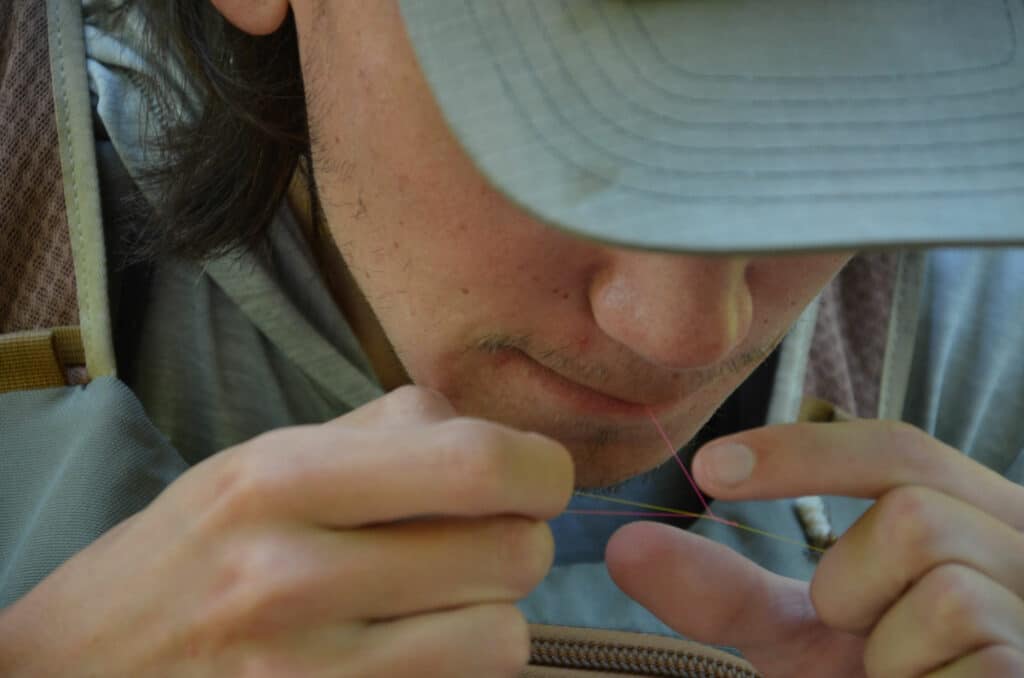
For beginners, Hawse suggests spooling up with normal floating fly line because it’s less expensive, it rarely leaves the reel when Euro nymphing, and it allows for versatility if you’d rather sling dry flies. For about $300, you can get a 10’ 6” Cortland Nymph Series rod in 2-weight to 4-weight, depending on the size of the river and fish you expect to encounter. Again, the reel doesn’t matter except as a weight balance. Hawse displayed the balance of his rig by placing two fingers under the handle and lifting the rod. It teetered briefly before balancing like a set of scales with his fingers as the fulcrum. This balance is important for your comfort on the water because of the repetitive nature of the technique.
Here’s a basic leader recipe: 10 feet of 8-lb. mono, 6 feet of 6-lb. mono, 6 feet of 4-lb. mono, 2 feet of 6x sighter, and 4 feet of 6x tippet. Sighter is brightly colored leader material that allows the angler to see exactly where their line is and what it’s doing.
Obviously, you’ll be fishing nymphs with your Euro nymph rig. The choice is yours on what you want to fish, from big heavy stoneflies down to tiny size 20 midge or Frenchie nymphs. Throw whatever matches the bugs you find under a rock or the subsurface version of the flies you see in the air. Or tie in a garishly bright attractor pattern. Importantly, the point fly in your rig should have some weight. Hawse said he likes nymphs tied with a tungsten head or a few wraps of lead. This weight helps with casting and control, and it also gets your flies down near the bottom quickly.
Hawse usually fishes just a single nymph, but when he fishes a tandem rig he ties the heaviest nymph to the end of the rig and another on the tag end of a blood knot, maybe 2 feet up the line. This heavier nymph is the point fly, and it should drift closer to the bottom and be the point of contact all the way up the leader to the rod and angler.
This constant contact is the primary benefit of the technique. With very little slack in the entire system, the angler can control the drift while maintaining natural presentation of the nymph. Bite detection and hook sets can be instant.
If all this sounds way too technical for your taste, know that it gets even more technical. However, like any pursuit or profession, the jargon makes relatively simple concepts seem unintelligible to an outsider. On the water, while watching Hawse pick apart runs, the technique seemed much easier to grasp.
The Technique
Hawse began his drifts standing on the bank. The lower Nantahala was high, as water generating electricity at the powerhouse careened through the gorge, carrying hooting tourists in brightly colored rafts on whitewater adventures. The fish don’t mind the rafts. If they spooked at every raft, they would starve to death.
An overhanging tree shaded the upstream side of a large eddy that swirled off swift water along the opposite bank. Hawse worked the tail of the run with a quick sequence of flicked casts and short drifts before he even stepped into the shallows. Obviously, there’s more to it, but Euro nymphing looks a lot like fishing with a long cane pole. You just lob that nymph out and then swing the rod tip smoothly to lead the drift.
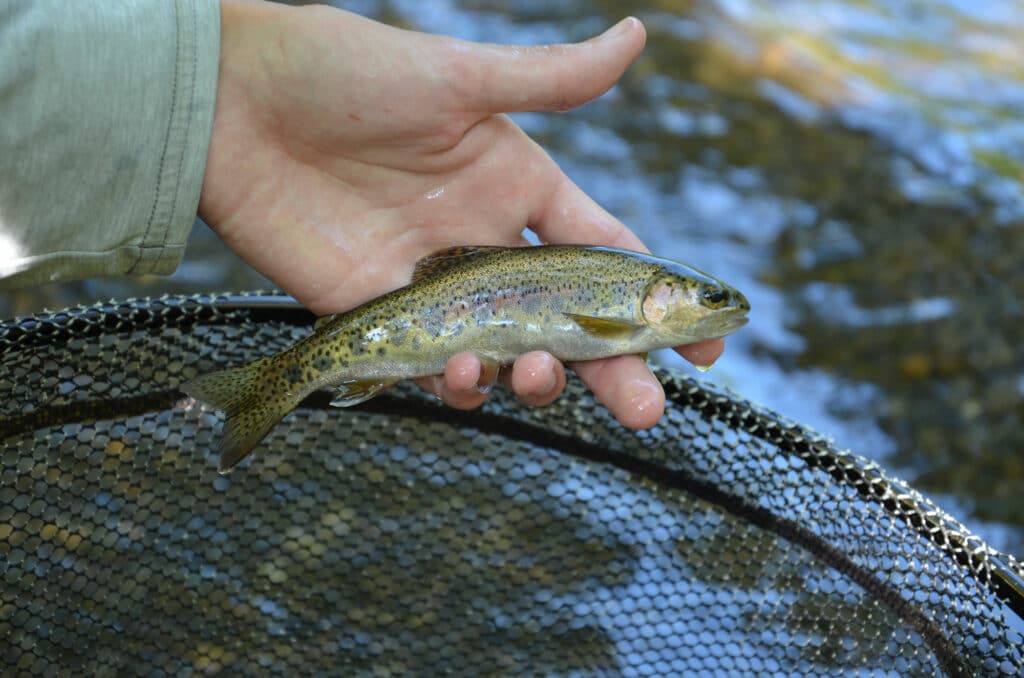
“You control the depth with the angle of your rod,” Hawse explained. He pitched his nymph to the shallower bank side of the run, and with the rod tip held high, used the same sweeping motion to lead the drift downstream at the same pace as the current. On subsequent casts and drifts, the angle of his rod in relation to the water closed—he held his rod tip lower—as he worked out toward the deep blue-green seam at the edge of the swift water.
Snap! With a twitch of his forearm, Hawse set the hook but missed. “Did you see him?” he said looking back at me. “Man, they’re quick today.”
Hawse fished the lower end of the run, covering every inch of water quickly and efficiently with a couple more missed hook sets before taking a couple steps upstream to begin the process again in fresh water. With a more traditional indicator rig, it would have taken numerous depth and weight adjustments to be so thorough, and the subtle strikes would probably have gone unnoticed because of the slack inherent in the system. Fishing with an indicator requires line mending and slack line, which also creates drag and presentations that are unnatural in the eyes of trout.
There is almost no slack line in Euro nymphing. The whole idea is to remain in contact with your nymph and to lead it smoothly downstream with the current. Hawse showed me a stripping technique he called a vector pull, which sounds complex, but it’s a simple method of retrieving line smoothly through the drift while retaining contact with the nymph. He also showed me a tuck cast, which piles the leader up on top of the nymph as it enters the water, so everything sinks faster. Like any style of fishing, there are countless tips and tricks and variations on the technique. The learning could go on for a lifetime, but becoming proficient is not too difficult with time spent on the water.
“Everyone wants to hold their arm out and lean forward,” said Hawse. His posture seemed relaxed, like he was leaning on a fence post, but his attention was rapt on the line where it entered the water. “I want to do it too, and sometimes you need to, but you can save your back and arm through a day of fishing if you stand up straight and keep your elbow at your side. I tell beginners to stand close to what they’re fishing and to fish what’s in front of them.”
As he spoke, he snapped the rod tip up with another quick hook set and came tight on a little wild rainbow trout, the first of the morning. He stripped it in quickly and scooped it with a giant net he pulled from his back.
In the moment, it dawned on me that I would have given up on the run after five or six good drifts with an indicator rig. Hawse had fished the water much more thoroughly with dozens of casts. He came into contact with at least four fish, caught one of them, and was disappointed at the lack of action.
All this occurred over the span of maybe 10 minutes in a single run. He went on to prove throughout the day that Euro nymphing is without a doubt a more efficient way to catch fish in most conditions.
What does a good day look like? Hawse said he fished a tournament on this same stretch of river, caught more than 100 fish in his allotted time, and placed fourth behind other Euro nymphers.
Cover photo: Grant Hawse, a trout guide from Sylva, N.C., fishes a Euro nymph rig on the tailwater stretch of North Carolina’s Nantahala River. All photos by Nick Carter
